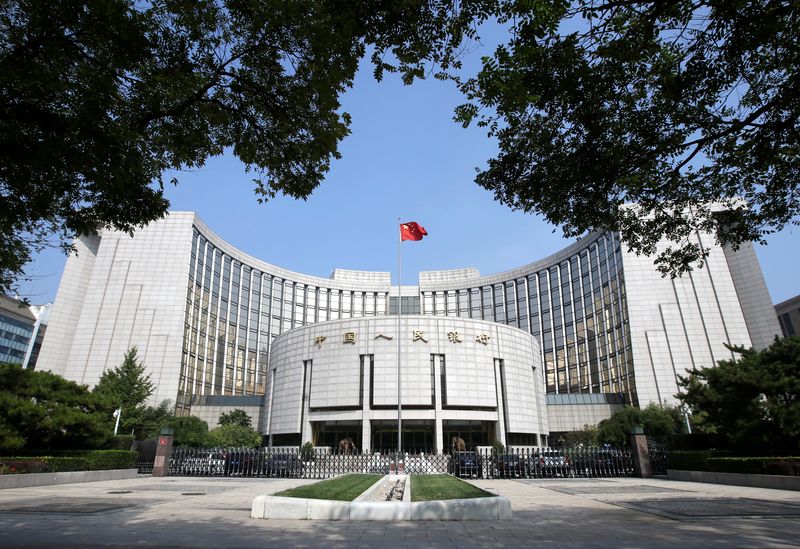By Kevin Yao
BEIJING (Reuters) - China's central bank is expected to deploy its most aggressive monetary tactics in a decade this year as it tries to stimulate the economy and soften the blow of impending U.S. tariff hikes, but in doing so it risks quickly exhausting its firepower.
Friday's announcement by the People's Bank of China (PBOC) that it has suspended treasury bond purchases due to the asset's scarcity highlights the limitations of its resources as it confronts an increasingly challenging economic environment.
Policy implementation is complicated by various factors, analysts say. There is the risk of currency and capital outflows, weak domestic credit demand and diminishing room to cut interest rates and inject liquidity by reducing reserve requirement ratios (RRR) - the amount of cash banks need to hold for rainy days.
These constraints are all interconnected. Further bond purchases, rate cuts or liquidity injections could exert depreciation pressure on the yuan, potentially causing funds needed for domestic growth to flow overseas.
Constraints were evident even before the bond buying suspension.
PBOC Governor Pan Gongsheng, in rare forward-looking remarks, flagged in September the possibility of another RRR cut by year-end, depending on market conditions but the cut has not occurred, despite the looser policy stance.
More monetary easing could support the economy in the near-term, but feed asset bubbles in the long term.
The PBOC has repeatedly warned that the bond rally that has pushed yields to record lows could undermine financial stability when markets turn.
"Short versus long term , internal versus external, and exchange rate versus interest rates – these are multiple conflicts," said Xing Zhaopeng, ANZ's senior China strategist
Faced with deflationary pressures and mounting headwinds to already stuttering growth, China's top leaders in December ditched their 14-year-old "prudent" monetary policy stance for a "moderately loose" posture.
But the space to cut interest rates and bank reserve requirements is smaller than the scale of easing deployed during the "prudent" era, implying that the PBOC may in practice have to be more careful than before, analysts say.
The PBOC's seven-day reverse repo rate, its new benchmark policy rate since last year, stands at 1.5% after a total of 30 basis point (bps) cuts in 2024. It is 203 bps lower than in May 2012, the first data point publicly available.
"Theoretically, the lower limit of interest rates is zero, as seen in the U.S. and Japan. However, I don't think China's rates will drop to zero," said Larry Hu, chief China economist at Macquarie.
Hu predicts 40 bps of policy rate cuts, which would still be the most aggressive annual reduction since 2015.
"If credit demand doesn't pick up, further rate cuts may not lead to increased lending and could instead create financial market bubbles," Hu said, adding that it would also hurt bank profitability and raise capital outflow risks by weakening the currency too fast and curbing confidence in the economy.
Business confidence is subdued and consumer sentiment is near record lows. Net interest margins at banks, a key measure of lending profitability, shrank to an all-time low of 1.53% in the third quarter of 2024.
Still, most analysts expect an RRR cut this month and a cumulative reduction of up to 100 bps throughout 2025 from the weighted average ratio of 6.6%. This would bring average RRR closer to the 5% threshold - currently the requirement for the smallest banks, widely seen as the lowest bound.
DIFFICULT TRANSITION
The diminishing room for cutting rates and RRR may also put a spanner in the works for the central bank's reforms.
The PBOC's stated aim - to reduce its "quantity-based" practices of leaning on banks to expand credit and rely more on interest rates for policy transmission so that markets play a more prominent role in funding the economy - is becoming increasingly difficult.
"A moderately loose monetary policy will involve both interest rate and quantitative measures," said Xu Hongcai, deputy director of the economic policy commission at the state-backed China Association of Policy Science.
Xu, who also predicts 40 bps of cuts, warns that the pace of easing needs to be balanced against exchange rate concerns.
"Excessive currency devaluation could destabilise financial markets, affect expectations and cause panic," Xu said.
Some analysts, including Hu and Xing, feel that the suspension of treasury bond purchases suggests the PBOC is uneasy about the disruptive effects of a fast weakening yuan.
But not all economists worry so much about a softer currency. In theory, it could make exports more competitive and mitigate the impact of U.S. tariffs, which incoming President Donald Trump threatened to hike to 60% on all imports of Chinese goods.
"Sacrificing monetary policy flexibility to maintain exchange rate stability would be a case of putting the cart before the horse," said Zhang Ming, a senior economist at think tank Chinese Academy of Social Sciences, in a Jan. 2 article on his WeChat account.

If rate cuts boost growth, the exchange rate may rise instead of depreciating, he said.
($1 = 7.3317 Chinese yuan)